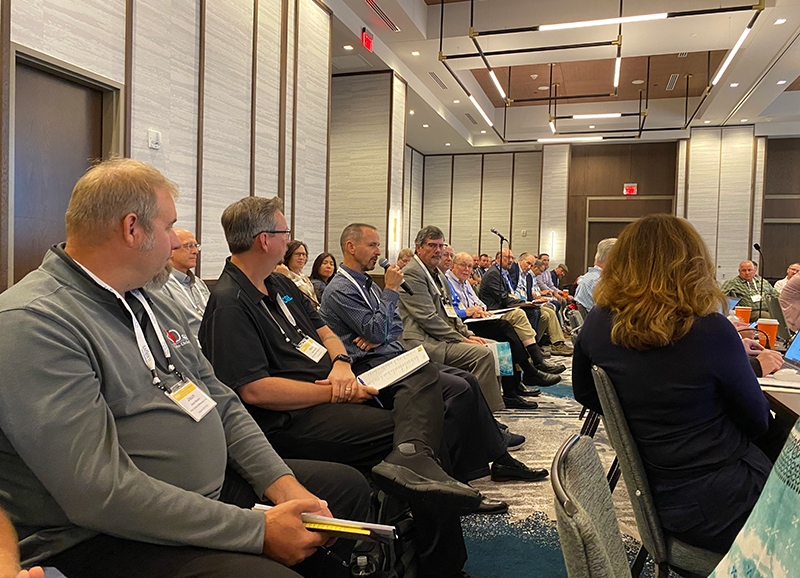NGA Glass Conference: Milwaukee explores the market and regulatory forces shaping the industry

About 100 glass industry members, including some of the leading technical experts on technology, sustainability and standards, met Aug. 6-8 for NGA Glass Conference: Milwaukee. Advancements in vacuum insulating glazing, material transparency standards, updated codes and opportunities for advocacy topped the agenda.
Find major takeaways below, and see more on-the-spot coverage from Norah Dick and Katy Devlin.
Vacuum insulating glazing: a proven technology
Leaders in vacuum insulating glazing technology came together to discuss current capabilities in VIG manufacturing, as well as how codes and standards may affect further adoption.
Vacuum insulating glazing refers to an insulating glass unit comprised of two glass lites that are hermetically sealed by the air being vacuumed or pumped out. The glass lites are then separated by small pillars or spacers; air is vacuumed through a pump-out port which is visible, though will not be in the next generation of products. Laminated and hybrid versions are also possible. Reference NGA’s free “Describing Architectural Glass” resource for more information on the types of VIG >
Panelists agreed that because VIG has an energy performance similar to a wall, reducing operational carbon significantly compared to other glazing units, it’s attractive to designers who want to increase the window to wall ratio on new construction. Their performance in the field has also been promising. “The failure rate [on installed VIGs] is very low,” said Guardian Glass’s Jon Griggs, manager of field service engineering. “The tech is not as unproven as people think.”
Codes do not drive adoption, but credits and incentives may
Tom Culp, NGA code consultant and owner of Birch Point Consulting, presented on the role of codes in VIG adoption, which is still minimal. Codes don’t yet drive VIG adoption, he said, but codes that incentivize better energy performance through tax credits will likely only be achieved through a high-performing product like VIG.
“There's a little bit of a chicken and egg scenario. In general, you can't set a prescriptive requirements code without showing a certain level of cost effectiveness, but then the costs of some of these products won’t come down until codes require it,” explained Culp. “So that puts VIG in a bit of a tough, weird spot in the code.”
The only place VIG is currently mentioned is with regards to refrigeration. ASHRAE 90.1 and IECC 2024 also offer additional credits for builders who go beyond base code. “So, you'd have to meet the base code and earn a certain number of extra points, so to speak. And those points are based on your building type and your climate zone, but it's meant to give flex to advance the energy code and give flexibility to the designer.”
Current and draft standards
Dave Cooper, president of VacuumGlass, reviewed several standards related to VIG development.
NFRC standard
The National Fenestration Ratings council can certify VIG products as of a few years ago. In order to keep proprietary technology confidential, the NFRC has created a C* star, which is “a coefficient or a factor that's used in the modeling simulation program, which will be able to hide a lot of the know- how and details from these VIG manufacturers but still allow the standard thermal simulations program,” said Cooper.
ASTM draft standard for working group 83445
Cooper said that ASTM draft standard for working group 83445 for load resistance and deflection had been in process for a little over a year. He said the goal was to be able to describe VIG as other glass constructions are described in ASTM E1300. Challenging the completion of the standard is a lack of testing data for systems over one meter by one meter “for deflection and actually breaking the IGs, showing the load resistance," he said.
“What we're doing is trying to find either a university or a lab that can do the ASTM testing according to E997, 998 on larger VIG units,” he said.
ASTM and ISO durability standards
Cooper and other industry members are also working on ASTM and ISO standards for VIG durability. The ASTM standard is 80% done, he said, with the goal of going to ballot this fall.
The existing ISO 199-16-1 standard for durability was completed in 2020. Since then, a standard for VIG temperature difference/thermal load has been created, with another standard in process for a pendulum impact test.
National Renewable Energy Laboratory
Robert Tenent, innovation lead Materials Science, Nanotechnology of the National Renewable Energy Laboratory talked through testing and adoption of VIG, speaking warmly of the product’s performance. “I've been working in fenestration technologies, in particular emerging tech for about 15 years, and this might be about the most excited that our team has been,” he said.
Much of the lab’s research on VIG focuses on durability, including vacuum failure and double differentials—the latter happens when one side of the VIG is heated and other is cooled.
Another, less-known type of VIG failure is desorption of materials from the inside of the glass surface, he said. This occurs when glass surfaces have either an amount of water on them or a volatile organic compound, which is likely if units are not cleaned during manufacturing. The fluids can be volatilized into the gap and cause loss of vacuum—this can happen a few different ways, and some are reversible, while others are not, said Tenent.
NGA Committee Updates
Read full updates from NGA's committees >
Forming Committee
The Forming Committee announced a new legislative tracking database for NGA members on Federal and State Buy Clean initiatives for low embodied carbon building materials. NGA will continue to work with stakeholders on these initiatives.
NGA Advocacy Committee
Committee members recapped the third annual NGA Glass & Glazing Advocacy Days held May 14-15, in Washington, D.C. At this annual event, NGA works with lobbying firm K&L Gates to connect member companies in small groups with members of Congress, as well as representatives from governmental agencies to make a positive connection for glass to legislators. The 2025 event is tentatively scheduled for May 13-14, 2025, pending updates to the congressional calendar.
NGA Fabricating Committee
The committee reviewed the new coding system for Glass Technical Papers (GTPs), which are balloted for systemic review every five years. If the GTP is republished with no technical changes, the original code is maintained with the current year added in parenthesis. If the GTP is revised with technical changes, the code is updated to reflect the current year.
NGA provides resources and support as material transparency requirements accelerate
NGA also announced several new resources to help member companies, and the industry, stay ahead of increasing sustainability requirements.
NGA will assist member companies in EPDs for fabricated glass products
Urmilla Sowell, vice president, Advocacy and Technical Services, and Tom Culp, NGA code consultant and owner of Birch Point Consulting, outlined the $2.1 million grant that NGA received from the Environmental Protection Agency for the purpose of helping to improve material transparency for the glass industry through the creation of Environmental Product Declarations, or EPDs. While EPDs for primary flat glass can be industry-wide, “life won’t stay that way for long,” Culp said, as requirements could include more product-specific EPDs for fabricated glass, as well as manufacturing location-specific EPDs.
NGA plans to use part of the NGA funding to provide technical, educational, and financial assistance to glass fabricator NGA members for EPD development. “We know it’s expensive for fabricators, especially if you have multiple plants,” said Sowell. “I’m glad we have funding to help this along.”
Relaunched World of Glass Map will add to recycling resources
NGA staff also marked the relaunch of its free World of Glass Map resource. This newly updated, more accessible version of the map is interactive and now hosted on glass.org. The map provides information about global float glass manufacturing locations and North American glass fabrication facilities, and as of October, will also include locations for glass recycling facilities. “The NGA knows that people are looking more and more for recycling data. It is really hard to find where your local recycler might be. We're hoping to bridge that gap with some new data,” says Georgia Scalfano, NGA's Sustainability Manager.
Part of the reason for this addition to the map is increased interest in recycling inside the industry, which was discussed during the Sustainability and Recycling Task Group update. “In 2022, people, even in the glass industry, didn’t know you could recycle glass,” said Jeremiah Watson, president, Infinite Recycled Technologies. “That’s not true now.”
The task group is also integral in creating and updating new resources on glass recycling, including “Moving the Needle on Architectural Glass,” which is currently at ballot and the updated FB40-14, “Recyclability of Architectural Glass Products.”
Part of the need for mapping the recycling needs and capacities of the industry currently is to stay ahead of potential regulatory bodies that may impose requirements through legislation, as has happened in other countries, says Kyle Sword, business development manager, NSG/Pilkington, NGA Board of Directors member and NGA Recycling task group Chair.
He underlined that understanding the industry’s recycling needs can be used as a tool for industry advocacy, by showing that the industry is progressing and what support is still needed. “What I really hope as we get to the point with our [Glass & Glazing Advocacy Days] that we really understand what it is that the industry needs [in terms of recycling]. We can actually go in and say, ‘Hey, we can do this, but here's the support we need and here's what that looks like. We don't really have an ask just yet.”
Chuck Wencl receives Harry Miles Award of Excellence
At an after-hours reception at the Milwaukee Art Museum, Chuck Wencl was awarded the Harry Miles Award of Excellence. Wencl, who is the sixth recipient of the award, has worked for 50 years as glass processing engineer at Viracon. Read the full story at glass.org >


